APHRODITE CULT 1
Greek Name
Αφροδιτη
Transliteration
Aphroditê
Latin Spelling
Aphrodite
Translation
Venus
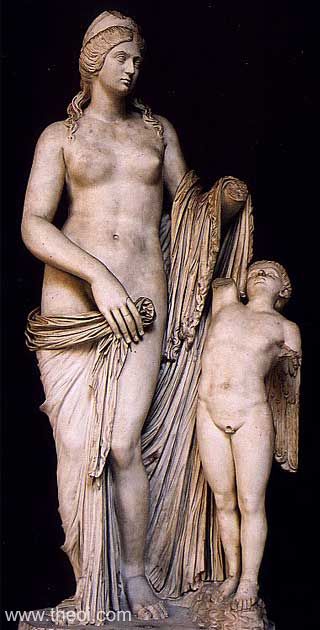
APHRODITE was the Olympian goddess of beauty, love and procreation.
Her cult was very popular in ancient Greece with numerous shrines and temples throughout the land. Her main cult centres within Greece were the city of Korinthos (Corinth) on the Isthmus, and the island of Kythera (Cytherea) off the coast of Lakedaimonia. Beyond Greece the island of Kypros (Cyprus) was famed for its Mystery cult of the goddess. Aphrodite was also worshipped with private rituals and prayers.
In classical sculpture Aphrodite was usually portrayed as a naked or partially disrobed women, often with her arms drawn in a futile gesture of modesty. The first nude Aphrodite was sculpted by the artist Praxiteles in the C5th B.C. as a cult idol for the city-state of Knidos (Cnidus). It was received with a certain amount of controversy in its day, but the style quickly became the norm.
CLASSICAL LITERATURE QUOTES
GENERAL CULT
Callimachus, Epigrams 39 (from A.P. 13. 24) (trans. Mair) (Greek poet C3rd B.C.)
:
"These gifts to Aphrodite did Simon, the light o' love, dedicate : a portrait of herself and the girdle
that kissed her breasts, and her torch, yea, and the wands which she, poor woman, sued to carry."
Philostratus the Elder, Imagines 2. 1 (trans. Fairbanks) (Greek rhetorician C3rd
A.D.) :
"[Ostensibly a description of an ancient Greek painting at Neapolis (Naples) depicting the worship of
Aphrodite :] An Aphrodite, made of ivory, delicate maidens are hymning in delicate myrtle groves. The chorister
who leads them is skilled in her art, and not yet past her youth; for a certain beauty rests even on her first
wrinkle, which, though it brings with it the gravity of age, yet tempers this with what remains of her prime.
The type of the goddess if that of Aphrodite Aidos (goddess of modesty), unclothed and decorous, and the
material is ivory, closely joined. However, the goddess is unwilling to seem painted, but she stands out as
though one could take hold of her . . . The maidens are singing, are singing, and the chorister frowns at one
who is off the key, clapping her hands and trying earnestly to bring her into tune . . . Eros, tilting up the
centre of his bow, lightly strikes the string for them and the bow-string resounds with a full harmony and
asserts that it possesses all the notes of a lyre; and swift are the eyes of the god as they recall, I fancy,
some particular measure. What, then, is the song they are singing? For indeed something of the subject has been
expressed in the painting; they are telling how Aphrodite was born from the sea through an emanation of Ouranos.
Upon which one of the islands she came ashore they do not yet tell, though doubtless they will name Paphos; but
they are singing clearly enough of her birth, for by looking upward they indicate that she is from Heaven
(Ouranos), and by slightly moving their upturned hands they show that she has come from the sea, and their smile
is an intimation of the sea's calm."
Suidas s.v. Aphrodision (trans. Suda On Line) (Byzantine Greek lexicon C10th A.D.)
:
"Aphrodision : Properly this is a shrine of Aphrodite."
Suidas s.v. Ephkhoi Pyroi :
"Ephkhoi Pyroi (boiled wheat-grains) : Aphrodisiacs. [Because] They used to offer wheat-grains to
Aphrodite."
Suidas s.v. Enoiketis ton neson :
"Enoiketis ton neson (she who inhabits the islands) : Aphrodite. For she was especially honoured
in them."
CULT IN ATTICA (SOUTHERN GREECE)
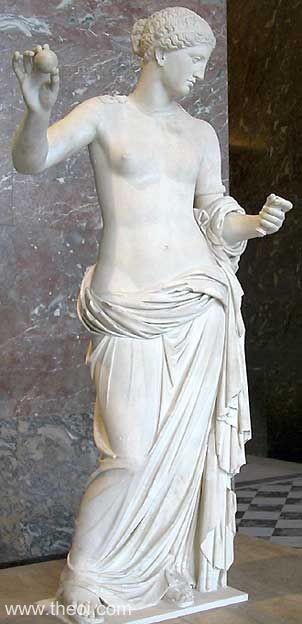
I. ATHENS (ATHENAI) Main City of Attica (Attika)
Pausanias, Description of Greece 1. 8. 4 (trans. Jones) (Greek travelogue C2nd A.D.)
:
"[There is a] sanctuary of Ares [in Athens], where are placed two images of Aphrodite, one of Ares made by
Alkamenes, and one of Athena."
Pausanias, Description of Greece 1. 14. 6 :
"Above the Kerameikos [in Athens] is a sanctuary of the Aphrodite Ourania (Heavenly); the first men to
establish her cult were the Assyrians, after the Assyrians the Paphians of Kypros and the Phoinikians who live
at Askalon in Palestine; the Phoinikians taught her worship to the people of Kythera. Among the Athenians the
cult was established by Aegeus, who thought that he was childless (he had, in fact, no children at the time )
and that his sisters had suffered their misfortune because of the wrath of Aphrodite Ourania (Heavenly). The
statue still extant is of Parian marble and is the work of Pheidias. One of the Athenian parishes is that of the
Athmoneis, who say that Porphyrion, an earlier king than Aktaios, founded their sanctuary of Ourania. But the
traditions current among the Parishes often differ altogether from those of the city."
Pausanias, Description of Greece 1. 19. 2 :
"Concerning the district called The Gardens [in Athens], and the temple of Aphrodite, there is no story
that is told by them, nor yet about the Aphrodite which stands near the temple. Now the shape of it is square,
like that of the Hermai, and the inscription declares that Aphrodite Ourania is the oldest of those called
Moirai (Fates). But the statue of Aphrodite Kepois (in the Gardens) is the work of Alkamenes, and one of the
most note worthy things in Athens."
Pausanias, Description of Greece 1. 22. 3 :
"When Theseus had united into one state the many Athenian parishes, he established the cults of Aphrodite
Pandemos (Common ) and of Peitho (Persuasion). The old statues no longer existed in my time, but those I saw
were the work of no inferior artists."
Plutarch, Life of Theseus 13. 7 (trans. Perrin) (Greek historian C1st to C2nd A.D.)
:
"The women [of Athens] were celebrating at that time the Adonia [festival of Aphrodite and Adonis], and in
many places throughout the city little images of the god were laid out for burial, and funeral rites were held
about them, with wailing cries of women, so that those who cared anything for such matters were
distressed."
Suidas s.v. Pandemos Aphrodite (trans. Suda On Line) (Byzantine Greek lexicon C10th
A.D.) :
"Pandemos Aphrodite : This is what they used to call the goddess established near the old agora [of
Athens], because of the fact that long ago the people gathered there in assemblies, which they called agorai.
Pandemos means common to all."
Suidas s.v. Zeuxis :
"Zeuxis : Aristotle [mentions him] as a painter in the time of Isokrates. In the temple of Aphrodite [at
Athens] this man painted a most beautiful Eros, crowned with roses."
Suidas s.v. Psithyristes :
"Psithyristes (Whispering) Hermes: There was a certain [cult of] Hermes at Athens which had this name. Also
honored at Athens were Whispering Aphrodite and Whispering Eros."
II. PIRAEUS (PEIRAIOS) Town of Attica
Pausanias, Description of Greece 1. 1. 3 (trans. Jones) (Greek travelogue C2nd A.D.)
:
"By the sea [at Peiraios, Attika] Konon built a sanctuary of Aphrodite, after he had crushed the
Lakedaimonian warships off Knidos in the Karian peninsula. For the Knidians hold Aphrodite in very great
honor."
III. COLIAS (KOLIAS) Promontory of Attica
Callimachus, Hecale Fragment 382 (from Suidas s.v. Kolias) (trans. Trypanis) (Greek
poet C3rd B.C.) :
"Kolias, name of a temple of Aphrodite . . . mentioned by Kallimakhos in the Hekale."
Strabo, Geography 9. 1. 21 (trans. Jones) (Greek geographer C1st B.C. to C1st A.D.)
:
"And in the neighborhood of Anaphlystos [in Attika] is . . . the temple of Aphrodite Kolias."
Pausanias, Description of Greece 1. 1. 5 (trans. Jones) (Greek travelogue C2nd A.D.)
:
"[On] the Kolias promontory [of Attika] . . . there is here an image of the Aphrodite Kolias, with the
goddesses Genetyllides (Goddesses of Birth ), as they are called."
IV. OROPUS (OROPOS) Village in Attica
Pausanias, Description of Greece 1. 34. 3 :
"The altar [of Amphiaraus at Oropos, Attika] shows parts . . . The fourth portion of the altar is to
Aphrodite and Panakea (All-Cure), and further to Iaso (Healing), Hygeia (Health) and Athena Healer."
V. CEPHISUS R. (KEPHISOS) River in Attica
Pausanias, Description of Greece 1. 37. 6 :
"After this [the river Kephisos, on the road to Eleusis, in Attika] is a temple of Aphrodite, before which
is a note worthy wall of unwrought stone."
CULT IN MEGARIS (SOUTHERN GREECE)
I. MEGARA Main Town of Megaris
Pausanias, Description of Greece 1. 40. 6 :
"When you have ascended the citadel [of Megara] . . . you see a temple of Dionysos Nyktelios (Nocturnal), a
sanctuary built to Aphrodite Epistrophia (She who turns men to love)."
Pausanias, Description of Greece 1. 43. 6 :
"After the sanctuary of Dionysos [in Megara] is a temple of Aphrodite, with an ivory image of Aphrodite
surnamed Praxis (Action ). This is the oldest object in the temple. There is also Peitho (Persuasion) and
another goddess, whom they name Paregoros (Consoler), works of Praxiteles. By Skopas are Eros (Love) and Himeros
(Desire) and Pothos (Yearning), if indeed their functions are as different as their names."
CULT IN SALAMIS (SOUTHERN GREECE)
I. SALAMIS Main Town of Salamis
Ovid, Metamorphoses 14. 759 ff (trans. Melville) (Roman epic C1st B.C. to C1st A.D.)
:
"Still at Salamis . . . there's a shrine of Venus Prospiciens [i.e. the Gazing Aphrodite]." [N.B. This
is from the story of Anaxarete.]
CULT IN AEGINA (SOUTHERN GREECE)
I. AEGINA (AIGINA) Main Town of Aegina
Pausanias, Description of Greece 2. 29. 6 (trans. Jones) (Greek travelogue C2nd A.D.)
:
"Near the harbor [of the island of Aigina] in which vessels mostly anchor is a temple of Aphrodite."
CULT IN CORINTHIA (SOUTHERN GREECE)
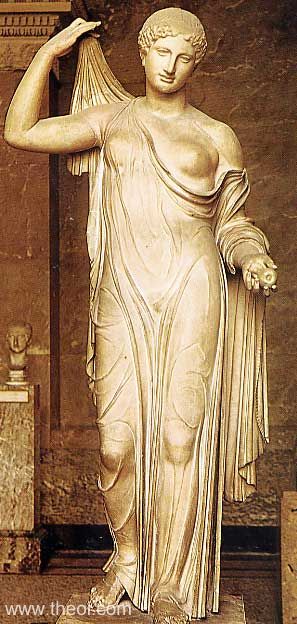
I. CORINTH (KORINTHOS) Main City of Corinthia (Korinthia)
Pindar, Eulogies Fragment 122 (trans. Sandys) (Greek lyric C5th B.C.) :
"Guest-loving girls [courtesans and prostitutes]! Servants of Peitho (Suasion) in wealthy Korinthos! Ye
that burn the golden tears of fresh frankincense, full often soaring upward in your souls unto Aphrodite."
Strabo, Geography 8. 6. 20 (trans. Jones) (Greek geographer C1st B.C. to C1st A.D.)
:
"The temple of Aphrodite [in Korinthos in the days of the tyrant Kypselos] was so rich that it owned more
than a thousand temple slaves, courtesans, whom both men and women had dedicated to the goddess. And therefore
it was also on account of these women that the city was crowded with people and grew rich; for instance, the
ship captains freely squandered their money, and hence the proverb, ‘Not for every man is the voyage to
Korinthos.’ . . .
Now the summit [of the Akrokorinthos] has a small temple of Aphrodite; and below the summit is the spring
Peirene . . . At any rate, Euripides says, ‘I am come, having left Akrokorinthos that is washed on all
sides, the sacred hill-city of Aphrodite.’"
Strabo, Geography 12. 4. 36 :
"Korinthos, there, on account of the multitude of courtesans, who were sacred to Aphrodite, outsiders
resorted in great numbers and kept holiday. And the merchants and soldiers who went there squandered all their
money so that the following proverb arose in reference to them: 'Not for every man is the voyage to
Korinthos."
Pausanias, Description of Greece 2. 2. 3 (trans. Jones) (Greek travelogue C2nd A.D.)
:
"In Kenchriai [the port of Korinthos] are a temple and a stone statue of Aphrodite."
Pausanias, Description of Greece 2. 2. 4 :
"Before the city [of Korinthos] is a grove of cypresses called Kraneon. Here are a precinct of
Bellerophontes, a temple of Aphrodite Melainis (the Black)."
Pausanias, Description of Greece 2. 2. 8 :
"[At Korinthos there is] a sanctuary for all the gods. Hard by is built a fountain . . . and a statue of
Aphrodite made by Hermogenes of Kythera."
Pausanias, Description of Greece 2. 4. 6 :
"The Acrokorinthos is a mountain peak above the city, assigned to Helios by Briareos when he acted as
adjudicator [i.e. between Helios and Poseidon in their contest for the city], and handed over, the Korinthians
say, by Helios to Aphrodite."
Pausanias, Description of Greece 2. 5. 1 :
"On the summit of the Akrokorinthos [the acropolis of Korinthos] is a temple of Aphrodite. The images are
Aphrodite Hoplismene (Armed), Helios, and Eros with a bow."
CULT IN SICYONIA (SOUTHERN GREECE)
I. SICYON (SIKYON) Main Town of Sicyonia (Sikyonia)
Pausanias, Description of Greece 2. 10. 4 :
"[In Sikyon] is an enclosure, sacred to Aphrodite. The first thing inside is a statue of Antiope. They say
that her sons were Sikyonians, and because of them the Sikyonians will have it that Antiope herself is related
to themselves. After this is the sanctuary of Aphrodite, into which enter only a female verger, who after her
appointment may not have intercourse with a man, and a virgin, called the Loutrophoros (Bath-bearer), holding
her sacred office for a year. All others are wont to behold the goddess from the entrance, and to pray from that
place. The image, which is seated, was made by the Sikyonian Kanakhos . . . It is made of gold and ivory, having
on its head a polos and carrying in one hand a poppy and in the other an apple. They offer the thighs of the
victims, excepting pigs; the other parts they burn for the goddess with juniper wood, but as the thighs are
burning they add to the offering a leaf of the paideros. This is a plant in the open parts of the enclosure, and
it grows nowhere else either in Sikyonia or in any other land. Its leaves are smaller than those of the esculent
oak, but larger than those of the holm; the shape is similar to that of the oak-leaf. One side is of a dark
color, the other is white. You might best compare the color to that of white-poplar leaves."
II. TITANE Village in Sicyonia
Pausanias, Description of Greece 2. 11. 8 :
"In the portico [of Asklepios at Titane, Sikyonia] are dedicated images of Dionysos and Hekate, with
Aphrodite, the Mother of the gods, and Tykhe (Fortune)."
CULT IN ARGOLIS (SOUTHERN GREECE)
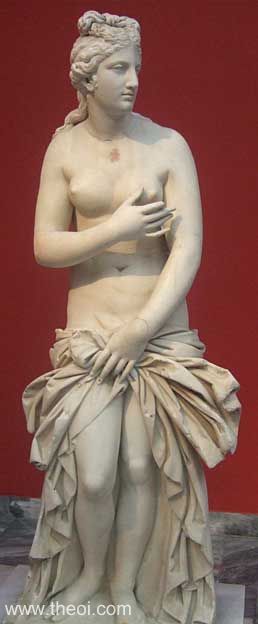
I. ARGOS Main City of Argolis
Pausanias, Description of Greece 2. 19. 6 :
"As to the wooden images of Aphrodite and Hermes [found in the temple of Apollon Lykeios in the city of
Argos], the one they say was made by Epeios, while the other is a votive offering of Hypermnestra. She was the
only one of the daughters of Danaus who neglected his command, and was accordingly brought to justice by him,
because be considered that his life was in danger so long as Lynkeus was at large, and that the refusal to share
in the crime of her sisters increased the disgrace of the contriver of the deed. On her trial she was acquitted
by the Argives, and to commemorate her escape she dedicated an image of Aphrodite, the Bringer of Victory."
Pausanias, Description of Greece 2. 20. 8 :
"Above the theater [in the city of Argos] is a sanctuary of Aphrodite, and before the image is a slab with
a representation wrought on it in relief of Telesilla, the lyric poetess."
Pausanias, Description of Greece 2. 23. 8 :
"Near the temple of Dionysos [in Argos] is a temple of Aphrodite Ourania (Heavenly)."
Pausanias, Description of Greece 2. 25. 1 :
"On this road [from Argos to Mantineia] is a sanctuary built with two rooms, having an entrance on the west
side and another on the east. At the latter is a wooden image of Aphrodite, and at the west entrance one of
Ares. They say that the images are votive offerings of [the mythical] Polyneikes and of the Argives who joined
him in the campaign to redress his wrongs."
Athenaeus, Deipnosophistae 3. 95f - 96a (trans. Gullick) (Greek rhetorician C2nd to
3rd A.D.) :
"As a matter of fact Kallimakhos [Greek poet C3rd B.C.] (or Zenodotos), in Historical Notes,
testifies that the pig is sacrificed to Aphrodite, in these words : ‘The people of Argos sacrifice swine
to Aphrodite and the festival is called Hysteria (Feast of Swine).’"
II. EPIDAURUS (EPIDAUROS) Town in Argolis
Pausanias, Description of Greece 2. 27. 5 (trans. Jones) (Greek travelogue C2nd A.D.)
:
"Within the grove [of Asklepios at Epidauros, Argolis] are a temple of Artemis, an image of Epione, a
sanctuary of Aphrodite and Themis."
Pausanias, Description of Greece 2. 29. 1 :
"There is also a sanctuary of Aphrodite [at Epidauros, Argolis]."
III. TROEZEN (TROIZENOS) Town in Argolis
Pausanias, Description of Greece 2. 32. 3 :
"[At Troizenos, Argolis] is a race-course called that of Hippolytos, and above it a temple of Aphrodite
Kataskopia (Spy or Peeping). For from here, whenever Hippolytos practised his exercises, Phaedra, who was in
love with him, used to gaze upon him. Here there still grew the myrtle, with its leaves, as I have described
above, pierced with holes. When Phaedra was in despair and could find no relief for her passion, she used to
vent her spleen upon the leaves of this myrtle. There is also the grave of Phaedra, not far from the tomb of
Hippolytus, which is a barrow near the myrtle."
Pausanias, Description of Greece 2. 32. 6 :
"You can see [in Troizenos, Argolis] a temple of Isis, and above it one of Aphrodite Akraia (of the
Height)."
Pausanias, Description of Greece 2. 32. 7 :
"Near the rock [of Theseus at Troizenos, Argolis] is a sanctuary of Aphrodite Nymphia (Bridal), made by
Theseus when he took Helene to wife."
IV. HERMIONE Town in Argolis
Pausanias, Description of Greece 2. 34. 11 :
"Hermione [in Argos], a city which I found afforded much to write about, and among the things which I
thought I myself must certainly mention are a temple of Aphrodite, surnamed both Pontia (of the Deep Sea ) and
Limenia (of the Harbor), and a white-marble image of huge size, and worth seeing for its artistic excellence
There is also another temple of Aphrodite. Among the honors paid her by the Hermionians is this custom :
maidens, and widows about to remarry, all sacrifice to her before wedding."
V. AMYMONE Springs in Argolis
Pausanias, Description of Greece 2. 37. 2 :
"By the sea [in the groves of Amymone, Argolis] is a stone image of Aphrodite."
VI. TEMENIUM (TEMENION) Village in Argolis
Pausanias, Description of Greece 2. 38. 1 :
"In Temenion [in Argolis] is built a sanctuary of Poseidon, as well as one of Aphrodite."
CULT IN LACEDAEMONIA (SOUTHERN GREECE)
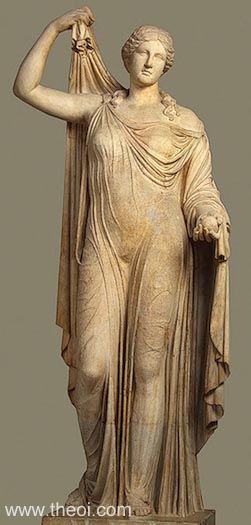
I. SPARTA Main City of Lacedaemonia (Lakedaimonia)
Greek Lyric V Folk Songs, Frag 864 (from Lucian, On Dancing) (trans. Campbell) (B.C.)
:
"The song sung by the Spartans while dancing is an invitation to Aphrodite and the Erotes to revel and
dance along with them."
Pausanias, Description of Greece 3. 12. 11 (trans. Jones) (Greek travelogue C2nd
A.D.) :
"By the Canopy [in Sparta, Lakedaimonia] is a circular building, and in it images of Zeus and Aphrodite
surnamed Olympia (Heavenly)."
Pausanias, Description of Greece 3. 13. 9 :
"[In Sparta, Lakedaimonia is] an old wooden image they call that of Aphrodite Hera. A mother is wont to
sacrifice to the goddess when a daughter is married."
Pausanias, Description of Greece 3. 15. 10 :
"A little farther on [in Sparta, Lakedaimonia] is a small hill, on which is an ancient temple with a wooden
image of Aphrodite armed. This is the only temple I know that has an upper storey built upon it. It is a
sanctuary of Morpho (the Shapely), a surname of Aphrodite, who sits wearing a veil and with fetters on her feet.
The story is that the fetters were put on her by [the mythical king] Tyndareus, who symbolized by the bonds the
faithfulness of wives to their husbands. The other account, that Tyndareus punished the goddess with fetters
because he thought that from Aphrodite had come the shame of his daughters, I will not admit for a moment. For
it were surely altogether silly to expect to punish the goddess by making a cedar figure and naming it
Aphrodite."
Pausanias, Description of Greece 3. 17. 5 :
"Behind the Lady of the Bronze House [at Sparta, Lakedaimonia] is a temple of Aphrodite Areia (Warlike ).
The wooden images are as old as any in Greece."
Pausanias, Description of Greece 3. 18. 1 :
"Near the statues of Pausanias [in Sparta, Lakedaimonia] is an image of Aphrodite Ambologera (Postponer of
Old Age), which was set up in accordance with an oracle."
II. AMYLCAE (AMYKLAI) Town in Lacedaemonia
Pausanias, Description of Greece 3. 18. 8 :
"Aristandros of Paros and Polykleitos of Argos have statues here [at Amyklai, Lakedaimonia]; the former a
woman with a lyre, supposed to be Sparta, the latter an Aphrodite called Amuklaios (of Amyklai)."
III. CRANAE (KRANAE) Island in Lacedaemonia
Pausanias, Description of Greece 3. 22. 1 :
"The island Kranai [off the coast of Lakedaimonia]: Homer says that when Alexandros [Paris of Troy] had
carried off Helene he had intercourse with her there for the first time. On the mainland opposite the island is
a sanctuary of Aphrodite Migonitis (Union), and the whole place is called Migonion. This sanctuary, they say,
was made by Alexandros. But when Menelaus had taken Ilion [Troy] and had returned safe home eight years after
the sack of Troy, he set up near the sanctuary of Migonitis an image of Thetis and the goddesses Praxidikai
(Exacters of Justice)."
IV. CYTHERA (KYTHERA) Island in Lacedaemonia
Herodotus, Histories 1. 105 (trans. Godley) (Greek historian C5th B.C.) :
"The city of Askalon in Syria . . . [has a] temple of Aphrodite Ourania [the Phoenician goddess Ashtarte].
This temple, I discover from making inquiry, is the oldest of all the temples of the goddess, for the temple in
Kypros [to Aphrodite] was founded from it, as the Kyprians themselves say; and the temple on Kythera was founded
by Phoinikians from this same land of Syria."
Pausanias, Description of Greece 3. 23. 1 (trans. Jones) (Greek travelogue C2nd A.D.)
:
"In Kythera [off the coast of Lakedaimonia] is . . . the sanctuary of Aphrodite Ourania (the Heavenly ) is
most holy, and it is the most ancient of all the sanctuaries of Aphrodite among the Greeks. The goddess herself
is represented by an armed image of wood."
Pausanias, Description of Greece 1. 14. 6 :
"Aphrodite Ourania (Heavenly); the first men to establish her cult were the Assyrians, after the Assyrians
the Paphians of Kypros and the Phoinikians who live at Askalon in Palestine; the Phoinikians taught her worship
to the people of Kythera."
V. TAENARUM (TAINARON) Village in Lacedaemonia
Pausanias, Description of Greece 3. 25. 9 :
"[At Tainaron, Lakedaimonia is] a temple of Aphrodite on the shore, with a standing statue of stone."
CULT IN MESSENIA (SOUTHERN GREECE)
I. MESSENE Main Town of Messenia
Pausanias, Description of Greece 4. 14. 2 :
"The Lakedaemonians first razed Ithome [in Messenia] to the ground, then attacked and captured the
remaining towns. Of the spoils [from Messene] they dedicated bronze tripods to the god of Amyklai [in
Lakedaimonia]. A statue of Aphrodite stands under the first tripod, of Artemis under the second, of Kore or
Demeter under the third."
Pausanias, Description of Greece 4. 31. 6 :
"[In Messene, Messenia] there are sanctuaries of the gods Poseidon and Aphrodite."
SOURCES
GREEK
- Pindar, Fragments - Greek Lyric C5th B.C.
- Greek Lyric V Folk Songs, Fragments - Greek Lyric B.C.
- Herodotus, Histories - Greek History C5th B.C.
- Strabo, Geography - Greek Geography C1st B.C. - C1st A.D.
- Pausanias, Description of Greece - Greek Travelogue C2nd A.D.
- Philostratus the Elder, Imagines - Greek Rhetoric C3rd A.D.
ROMAN
- Ovid, Metamorphoses - Latin Epic C1st B.C. - C1st A.D.
BYZANTINE
- Suidas, The Suda - Byzantine Greek Lexicon C10th A.D.
BIBLIOGRAPHY
A complete bibliography of the translations quoted on this page.